I have an opinion.
I try not to have very many opinions, because I think that makes me opinionated (funny how that works), and I might not have all the facts to form a good opinion.
Yet, I have an opinion.
I’m uncertain about the Confederacy.
I have an opinion, yet I’m uncertain about it.
I’m most uncertain about living in the South and being part of the Confederacy. Part of that uncertainty comes from being from East Tennessee, which was predominantly Union, although I didn’t know that until I grew up, which could mentally be viewed as rather recently.
I grew up at the beginning crest of the Civil Rights Movement. I remember when my elementary school was integrated. I was there, and it was skillfully done. Yet I saw other images on national television news, spewing hate and hope.
So to me, the War seemed to be about slavery, although others will point out that it had to do with states’ rights. I wasn’t there so I can’t form a hard and fast opinion about it.
Yet, I’m bothered about slavery. There’s times when I’ve felt rather slavish myself, which certainly doesn’t mean that I understand completely the daily life of a slave.
I didn’t think that I wanted to go to the Museum of the Confederacy, even though my cousin works there. He’s the President and the CEO, yet he doesn’t know me from Adam’s housecat. I sent him an email of introduction a few months before we went on this trip, and I never heard from him. Maybe my email is sitting in his spam folder.
I know that he’s a cousin because he and my BigBroBob had the DNA testing, and the test placed them in the same group originating in Nansemond County, Virginia. We don’t know who the common ancestor is, yet, and maybe we’ll never know.
Well, whatever.
*****
Sugar wanted to go because a certain Garnett’s sword was supposed to be at the museum. And also seeing how Jefferson Davis’s sister is Sugar’s ancestor, it seemed that we should go. But still I had doubts.
We met a couple at breakfast who had gone. They were from the remote Midwest, and their families weren’t even in America during the war, and they felt compelled to go. They clinched my opinion to go when they said that the exhibits made the war very real. There was clothing on display, like uniforms with bullet holes in them.
And bloodstains. Bloody, bullet-ridden clothing. My father’s great-uncle lost a leg at Shiloh. He had been left on the battlefield for dead.
So if these complete breakfast-strangers felt compelled to go, even with no familial investment, perhaps I should go, too, and so I conceded.
*****
Dear Lord, the tourists in Richmond. The town was thick with them, just like Savannah. We didn’t know where to park, and we finally found a place in a lot blocks away from the museum. Did I say that it was hot?
WHITE HOUSE OF
THE CONFEDERACY
* * * * *
Built in 1818 as the residence of Dr. John
Brockenbrough, this National Historic Landmark
is best known as the executive mansion for
the Confederate States of America, 1861 – 1865.
President Jefferson Davis and his family lived
here until Confederate forces evacuated Richmond
on 2 April 1865. After serving five years as
the headquarters of Federal occupation troops,
the house became one of Richmond’s first
public schools. In 1890, the Confederate
Memorial Literary Society saved the mansion
from destruction and between 1896 and 1976
used it as the Confederate Museum. The Society
restored the house to its wartime appearance
and reopened it to the public in 1988.
The White House was next to the museum.
The city has grown up around the White House and the Museum, and tall buildings now surround this little Confederate compound.
We went inside the museum, and Sugar joked that my cousin might sweep down the staircase in a show of welcome. That did not happen.
Uniform Frock Coat of Major General Richard Stoddert Ewell
Virginia native and West Point graduate Richard Ewell commanded a
division in “Stonewall” Jackson’s army during the Valley Campaign.
During the Seven Days Battles, Ewell’s division was heavily engaged at
Gaines’ Mill and Malvern Hill. After Jackson’s death in May 1863, Ewell
succeeded to the command of his corps.
Temporarily Removed from Exhibition
*****
Ambrotype Photograph of Privates Columbus Christopher Taylor
(left), James H. Porter (center), and James D. Jackson (right)
The three comrades of Company D, 3rd Georgia Infantry, posed together
for the photographer early in the war. Taylor and Jackson were among 23
men in the regiment killed in the carnage at Malvern Hill.
Charge of Confederates Upon Randol’s Battery at Frayser’ Farm
Sketch by Allen Christian Redwood published in Century Magazine, 1885
Artist Allen Redwood was a soldier in Capt. William Wright’s company of
the 55th Virginia Infantry. The regiment and the rest of Maj. Gen. A. P.
Hill’s division were heavily engaged at Frayser’s Farm, capturing an
enemy artillery battery and a Federal general. Before Frayser’s Farm,
Redwood wrote later, the men of Hill’s so-called Light Division “had
scarcely known and cared less to which division of the army they belonged;
now if you asked one of them he would answer, with a perceptible pride in
his men and in his voice, the (sic) he was one of Hill’s ‘Light Bobs.’
*****
The Effects of Captain William Alfred Wright
French manufactured Model 1850 Foot Officers Sword
Filter type Canteen and Bullet
A native of Tappahannock, Virginia, 30-year-old William Wright had been
promoted to captain of Company F (the “Essex Sharpshooters”), 55th
Virginia Infantry, on June 24, 1862. Si days later he was killed at
Frayser’s Farm by a bullet that passed through his body and through his
canteen. His comrades and family saved the bullet that killed him.
Tower Enfield Rifle Musket
Picked up at Willis Church on the Frayser’s Farm battlefield, this Enfield
rifle was said to have been used in the battle by a Louisiana Zouave.
Carved in the stock
LC
LA Zv
Ramrods used to Mark Graves at Shiloh
The human loss at Shiloh was staggering. It was the largest and bloodiest
battle yet fought on the North American continent. Casualties were five
times higher than those at First Manassas. The Confederates lost 11,000
(killed, missing, and wounded) of the 40,000 engaged, while the Federals
lost 13,000 of their 63,000 men.
Garnett’s Brigade
During the Charge
Samuel Paulett of the 18th Virginia looked
across the wide open expanse in front of
the Union lines, a thousand yards of open
ground from their present position to the
enemy. “My heart almost failed me,” he
recalled. He turned to his comrades.
“This is going to be a heller. Prepare for the worst!”
Richard Garnett’s brigade formed the center of Pickett’s
division. Garnett was ill that day and, unable to go on foot,
led his brigade on horseback “waving his hat and cheering his
men on.”
As his brigade, its ranks thinned by the withering fire from
the Federals, got close to the stone wall at the crest of the hill,
Garnett shouted, “Faster men, faster. We are almost there!”
Then, wrote Major Charles Peyton, the Virginians “recoiled
under the terrific fire that poured into our ranks both from
their batteries and from their sheltered infantry.” General
Garnett disappeared in a hail of shot and smoke. No one
would see him again. His body was never identified and he
was presumable buried in one of the mass graves after the
battle.
Sword of Brigadier General
Richard Brooke Garnett
Presented to the museum in 1919 by Mrs. John B. Purcell
Killed only yards from the Union’s position
atop Cemetery Ridge, Gen. Garnett’s body was
never found, but his sword turned up in a
second-hand shop in Baltimore after the war. It
was purchased by former Confederate General
George Steuart and eventually made it into the
hands of Garnett’s niece.
Letter from Gen. William Pendleton to William
Garnett, father of Gen. Richard Garnett
Presented to the museum by Alfred L. Garnett
[excerpt]
Hd. Qrs. Arty. Corps
Hagerstown, Md. July 9th, 1863
My Dear Friend,
The heart rending tidings will have reached you
before this, of your son’s death in the battle of Gettysburg
on the 3rd ist. He fell in a gallant charge upon the
enemy’s strong hold which was shared by his brigade. So
far as I could learn his body, in common with those of
many officers and men, was not recovered; it having
been found impracticable, without support which did not
arrive, to hold or recover the ground gained in the
charge.
What can I say to mitigate your anguish under this
heavy blow? I could dwell upon Gen’l Garnett’s
excellent qualities, but that were quite superfluous, fully
known as he was to yourself. On the march from
Fredericksburg I several times saw him. He was always
the same cheerful, frank-hearted man and attentive
officer. All, I am sure, esteemed him.
….Then at the brief command of Lee
Moved out that matchless infantry,
With Pickett leading grandly down,
To rush against the roaring crown
Of those dread heights of destiny.
….A thousand fell where Kemper led;
A thousand died where Garnett bled;
In blinding flame and strangling smoke
The remnant through the batteries broke
And crossed the works with Armistead….
“The High Tide at Gettysburg” (excerpt) by Will H. Thompson, 1888
Sugar looks at his cousin Winnie Davis.
Brooch with hardtack (Army Bread)
Presented to the Museum by Mrs. Henderson Bell in 1979
Richard Baylor (or Balor) made this brooch by encasing a small piece of
hardtack in gold filigree. He served in Thomas Rosser’s Brigade, and may
have saved the piece of hardtack from his rations at the end of the war.
Bone Brooch of Turner Ashby’s Horse Gallant Gray
Presented to the Museum by Sallie E. Alexander in 1905.
Turner Ashby and his horse, Gallant Gray, were killed in the same charge
in June 1862. Sallie E. Casler found the boneon the ground several months
later. Her brother, John O. Casler, later carved the bone and set it in a
brooch for her to wear.
Beef Bone and Earrings
Presented to the Museum by Mrs. Louise F. Bossieux in 1898.
Carved by a Federal prisoner of war at Libby Prison in Richmond in 1864,
this jewelry was given to Capt. John Latouch, Adjutant of the prison.
I wonder if this Mrs. Louise F. Bossieux is related to “Mr. Boisseau”, who is referred to in William Starr Basinger’s “Personal Reminiscences”?
Carte de Visite of Varina Anne “Winnie” Davis
The youngest daughter of Confederate president Jefferson Davis
and his wife Varina was known as “The Daughter of the
Confederacy.” The peasant cross is visible in this photograph,
which was taken in Richmond in 1880, when she was 16 years old.
(Winnie was present with her father in Savannah at the dedication of the Telfair Academy of Arts and Sciences in 1886. Time and space continue to link us all together.)
Horse Bit presented to Nathan Bedford Forrest
Presented to the Museum by Mrs. W. C. D. Vaught in 1899.
A man known only as F. Walker made the custom curb bit for General
Nathan Bedford Forrest. Silver dollars were used to provide the plating on
the decorative stars, which is now nearly worn away. Note the stylized “C”
and “S” for Confederate States) that form the branches of the bit.
Hoof of Turner Ashby’s Horse Tom Telegraph
Presented to the Museum by Dr. C. O Miller in 1924.
General Ashby and his white horse, Tom Telegraph, were famous figures
in the Confederate cavalry. Even a Union foe described the hose as being
“disciplined like his master, to the accomplishment of the most wonderful
feats.” Tom Telegraph was mortally wounded near New Market, Virginia
on April 17, 1862. At some unknown time thereafter his remains were
taken for souvenirs.
Compare this modern-day photo to the one in the historical marker below.
PRESIDENT’S MANSION
White House of the Confederacy
This house was the executive mansion of Confed-
erate President Jefferson Davis and his family
from August 1862 until April 2, 1865. A West
Point graduate, former U.S. senator from Missis-
sippi, and former U.S. secretary of war, Davis
was the Confederacy’s oly president. He worked
long hours here, meeting with Confederate civil-
ian and military leaders. On April 14, 1862, he
held a council of war here with Secretary of War
George W. Randolph,
Gen. Joseph E. Johnston, Gen. Robert E.
Lee, and other officers
to discuss the Con-
federacy’s defense
against Union Gen.
George B. McClellan’s
advancing army.
More often, the
house was the site of
official receptions and
unofficial parties. One
observer declared Confederate First Lady Varina
Davis “to be a woman of warm heart and impetus-
ous tongue, witty and caustic, with a sensitive
nature underlying all; a devoted wife and mother,
and a most gracious mistress of a salon.”
The Davises’ young family enlivened the
White House. “Statesmen passing through the
halls on their way to the discussion of weighty
things were likely to hear the ringing laughter of
the care-free and happy Davis children issuing
from somewhere above the stairs or the gardens,”
remembered a family friend. Two Davis children,
William and Varina Anne, were born in this
house; one, Joseph, died here from a fall on April
30, 1864.
On April 4, 1865, U.S. President Abraham
Lincoln visited here ten days before his assassin-
nation and less than 48 hours after Davis depart-
ed. Here, Lincoln began meeting with prominent
Virginians to discuss the state’s reconstruction.
Yes, I’m glad I went. I can cross that off my list.
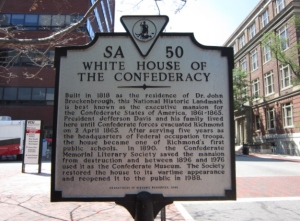
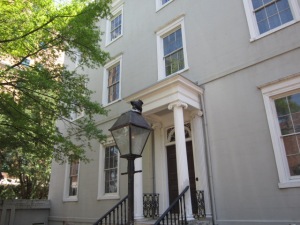
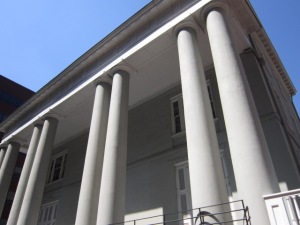
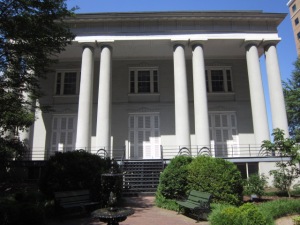
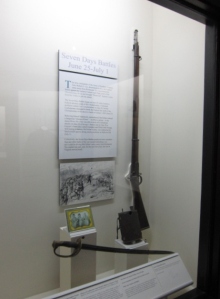
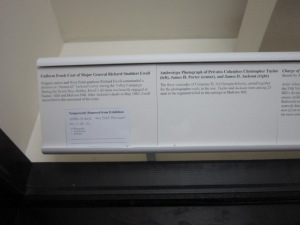
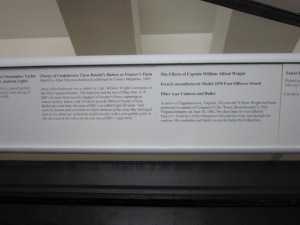
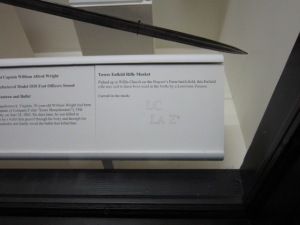
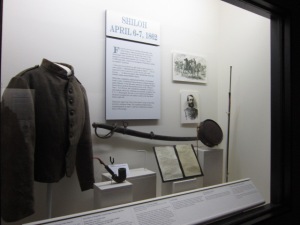
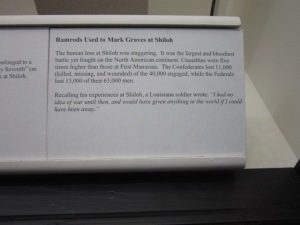
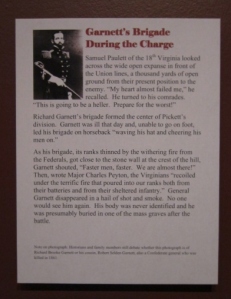
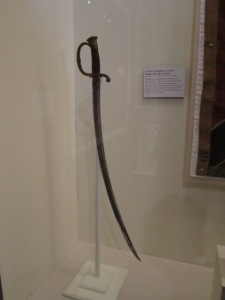
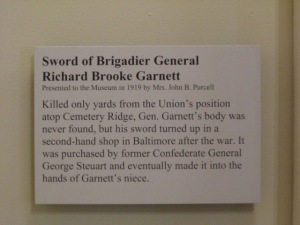
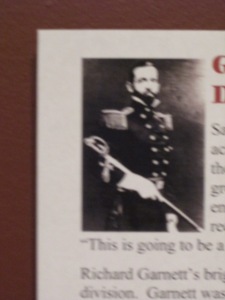
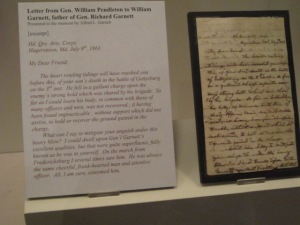
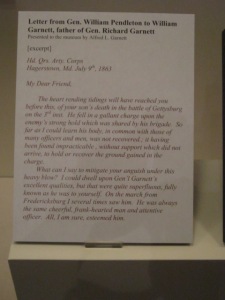
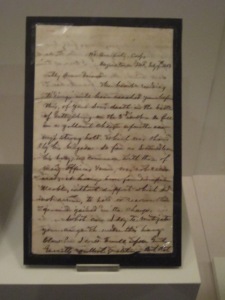
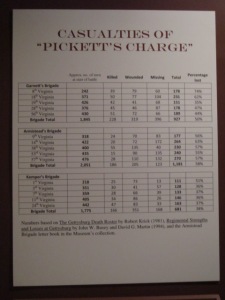
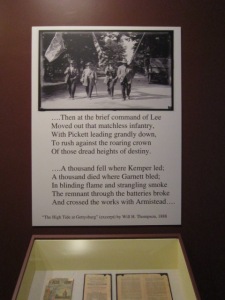
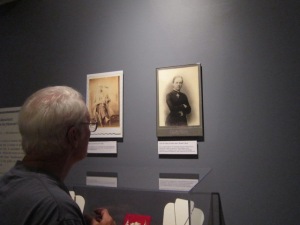
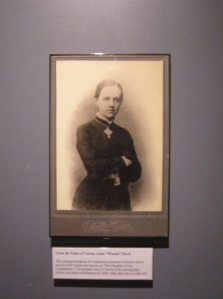
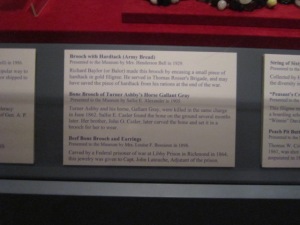
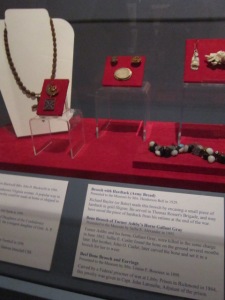
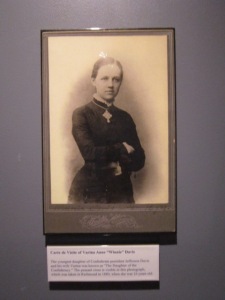
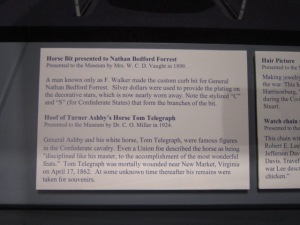
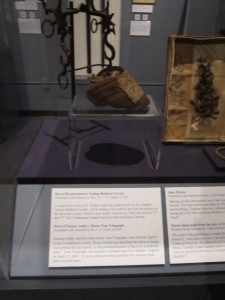
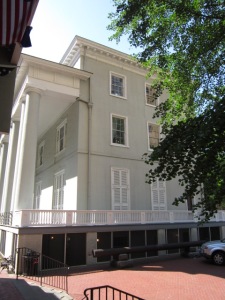
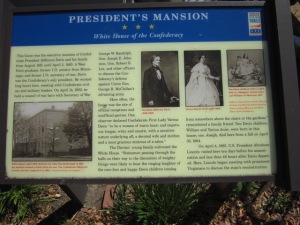
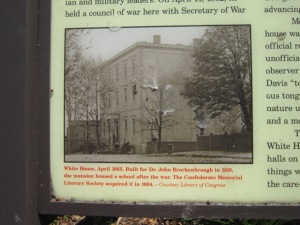
August 5, 2013 at 9:02 pm |
I am glad you are glad that you went. I grew up in Richmond, and even though the war was almost 100 years before my birth, it still lingered. I am conflicted about many aspects of it as well. But anyway, in the little elementary school I went to, my fifth grade class put on a little show that was sort of a panorama of American history. Each of us students dressed up from a different time period and the class sang period songs from the Indians all the way through World War II. My friend and I dressed up as girls from the 1860s and two of the boys in the class were a Union and a Confederate soldier, respectively. Our song was “When Johnny Comes Marching Home.” We performed the program for our schoolmates, and then we were invited to perform the whole show for the Confederate Home for Ladies, a nursing home facility for descendants of Confederate soldiers. One of the residents was Robert E. Lee’s grand-niece. My three 1860s friend and I got our picture taken with her. And they put it in the newspaper! It was very exciting.
LikeLike
August 6, 2013 at 8:06 am |
Dawn, thank you for that comment. I love the use of your word “conflicted”.
And thank you for preserving that childhood memory. Do you remember the name of the newspaper?
LikeLike
August 8, 2013 at 3:06 pm |
Ruth,
I never got your earlier email, so please forgive my lack of reply then. And I wish I had known about your visit. I would have given you the “family tour.” Let me know when you come back.
Waite Rawls
President, Museum of the Confederacy
LikeLike
August 8, 2013 at 8:30 pm |
Hello Waite, and welcome to the blog!
Here’s my email to you on April 2, 2013. I’ve changed Sugar’s real name and where he lives.
Mr. Rawls,
I write you at the request of my friend Sugar, a Savannah native now living in SC.
His great-grandfather was William Starr Basinger, a member of the Savannah Volunteer Guards. We recently went to the University of North Carolina at Chapel Hill to view the William Starr Basinger Family Papers. W. S. Basinger was in the battle at Sailor Creek at the end of the war, and he became a prisoner of war. I am in the process of transcribing the papers and posting them online on my blog.
However, that is not the reason that I write to you. W. S. Basinger wrote a book of reminiscences, of which 6 were published. One copy is at the University of Georgia in Athens, and Sugar has a copy. We do not know what happened to the remaining 4 books.
Mr. Sugar is interested in having this book published, and he has considered that you might be able to direct him or assist him in some manner.
Any advice you can offer will be welcome.
Ruth Rawls
P.S. Yes, my father is part of the Nansemond County Rawls group.
LikeLiked by 1 person
August 18, 2013 at 11:54 pm |
Reg and I toured Shiloh a couple of weekends ago. It had been several years since our last trip there. They showed a recent and interesting video about the battle narrated by Peter Coyote. Do you have name of Daddy’s great-uncle who lost his leg there?
LikeLike
August 19, 2013 at 9:19 am |
Of course I have his name! He’s Charles W. “Charley” Burgess. I’ll write a post about him. In 1893 or thereabouts, he married a much-younger woman with a child, the child being about age 4. I’m guessing that she was a young widow. On the 1900 census, he was about 60 and she was about 32, and they had been married for about 7 years. They were living in Corinth, Alcorn County, Mississippi. If you get on a mule in Henry/Weakley Counties in Tennessee, and head due south, you’ll end up in Alcorn County. It seems like I have his service record somewhere around this barn. Dad told me a story once about him. Charley’s family knew that he was returning from the war, and they weren’t sure how to treat him, him being an invalid and all. They said Charley rode up on a horse, and hopped right down like nothing was wrong, except, of course, that he was missing a leg. I would have loved to see their faces at his homecoming. Imagine the relief. He went on to manage a livery stable. Can y’all head on down to Alcorn County now?
LikeLike
August 19, 2013 at 9:26 pm |
Heart-wa, uh, ear-warming statement to read ~ “I’ll write a post about him.” I was hoping that was what your response would be. 🙂 Corinth has also been subjected to a visit from Mr. and Mrs. Nerd on the occasion of my first visit to Shiloh. We stayed overnight in Corinth, saw the Civil War Interpretive Center, the Coke and Railroad Museum, and ate at the General’s Quarters B & B there. You and Sugar come west anytime and check out some of our glories!! ( I was guessing Charley was born around 1840 in order to be in the Civil War and still be Daddy’s great-uncle. )
LikeLike
June 11, 2019 at 5:19 pm |
interested in Nansemond Rawls..name Ruth Rawls,granddaughter of Rawls Confederate veteram of Alabama.
LikeLiked by 1 person
June 11, 2019 at 5:52 pm |
Hello, and welcome to the blog! If you would like to give me more detail, you could email me at ruthmarierawls@gmail.com. I look forward to more news!
LikeLike